Analysed: Six No 9s that Liverpool could target

Liverpool’s summer plans, like everyone else’s, very much hinge on data and not dates.
The datapoints in question for Michael Edwards, Jurgen Klopp and co are European qualification, player sales, and how the needs of their squad could change over the coming months. The summer plans? How to evolve this squad to challenge again next season. A big part of that is what to do up front, with there being a solid case for Liverpool buying a new No 9.
The first important datapoint is European qualification. The cost of missing out on the Champions League would be a purely financial one, having little to no impact on Liverpool’s ability to attract players despite not featuring at the top level of European competition in 2021-22. That financial cost would be sizeable, though.
Qualifying for the Champions League is worth at least €40 million to a Premier League club, with additional bonuses of €2.7 million and €0.9 million awarded for each group stage win or draw. Reaching the knockout phase brings a further bonus of €9.5 million. If Liverpool can get past RB Leipzig on March 10 to make the quarter-finals, that’s another €10.5 million in the bank.
A bad Champions League run then will still net a Premier League side €40 million-€50 million. Liverpool’s campaign in 2018-19 — a good run by all accounts — earned them €111 million.
Europa League qualification would still bring with it a financial shot in the arm, but to a lesser extent. A bad campaign in that competition brings in about €20 million, and winning it around €45 million.
With Liverpool’s wage bill well over £300 million and a reduction in revenue due to the sheer volume of games played behind closed doors over the past eight months and counting, it’s obvious how missing out on the highest level of European competition next season will impact things.
According to Opta’s predictive model, there’s a 58 per cent chance of Liverpool finishing in the top four, and therefore securing automatic Champions League qualification. That’s better than a coin flip, but only just.
If Liverpool don’t feature in next season’s Champions League, it’s unlikely that the missing revenue can be fully accounted for through fringe player sales, which is that second key datapoint. Ben Woodburn, Marko Grujic, Loris Karius and Harry Wilson are all candidates to be shown the door, but, between them, are unlikely to generate the sort of money Liverpool would require to bring in top-calibre talent.
Lastly, it’s the relative importance to strengthen within each position.
Here’s how the Liverpool squad looks ahead of the new season.
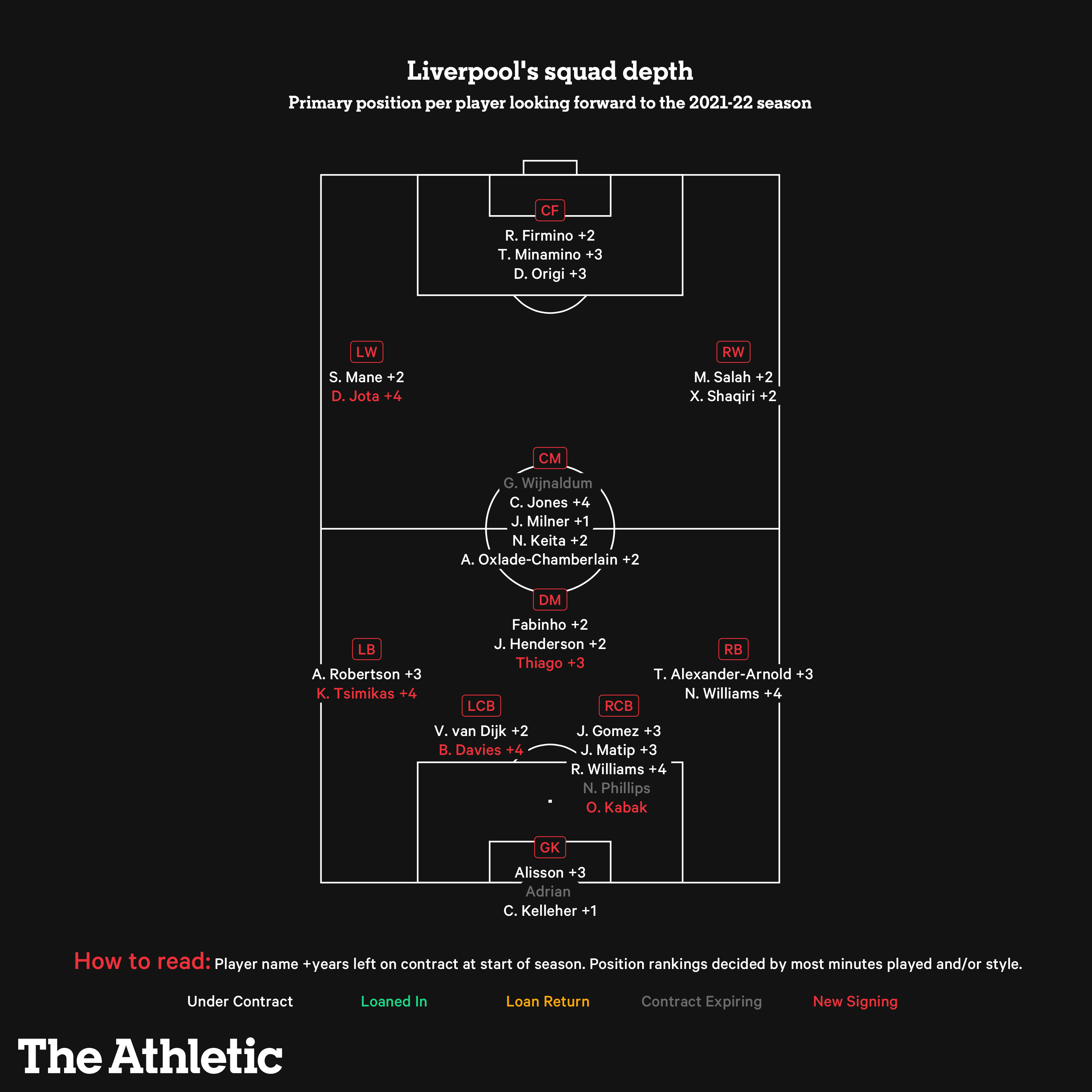
Klopp’s full-back positions are relatively well-stocked, especially when you consider James Milner’s ability to slot in on either side when required, too. Defensive midfield is also a position of relative strength, especially if Fabinho gets to ply his trade there again next season rather than filling in elsewhere. Striker aside, the two other positions which require attention this summer are centre-back and central midfield.
The issues at the back will be partly resolved by Joe Gomez and Virgil van Dijk returning from their long-term injuries. The permanent signing of Ozan Kabak after his “try before you buy” loan could ease the impact of any further injuries too, preventing next season from being as disrupted by them in the process. Kabak would cost in the region of £18 million to turn his loan into a permanent deal.
Central midfield is slightly different. With Georginio Wijnaldum’s contract coming to an end this summer, Liverpool are likely to lose their most relied-upon midfielder of recent times. Wijnaldum, their tidy pressure-reliever, has featured in all but nine league games since he arrived in 2016-17. If he is to depart, it leaves the young but highly capable Curtis Jones, a 35-year-old Milner and the injury-prone duo of Naby Keita and Alex Oxlade-Chamberlain. The latter two have featured in eight fewer games combined than Wijnaldum since the start of 2018-19.
The focus here, though, is to identify some options who play up front. With Divock Origi likely off this summer too and Takumi Minamino perhaps not showing enough in his limited game time to rely on him as a back-up striker, there’s plenty of need for a new face.
It’s hard to nail down exactly the profile that Liverpool may be looking for, so we’ll hedge our bets across two types of player.
If Origi is to leave, Liverpool are left without a traditional No 9 type whose sole focus is to score goals. Those sorts of players will be half of the final shortlist. The other half will be those players who complement Roberto Firmino, also profiling like false nines.
Below is Firmino’s profile for this Premier League season, using data from smarterscout.
Smarterscout is a site that gives players a rating from zero to 99, relating to either how often they perform a given stylistic action (such as shooting volume) or how effective they are (such as measuring how well they progress the ball upfield) compared with others playing in their position.
Firmino is above average (which is 50 out of 99 on these charts) when it comes to helping his team to score and to get the ball upfield, but he doesn’t excel at either. He’s deeply involved in linking play (for a striker), above average at retaining possession, isn’t an overly high-volume shooter or receiver of passes into the box, and is a very active defender when out of possession.
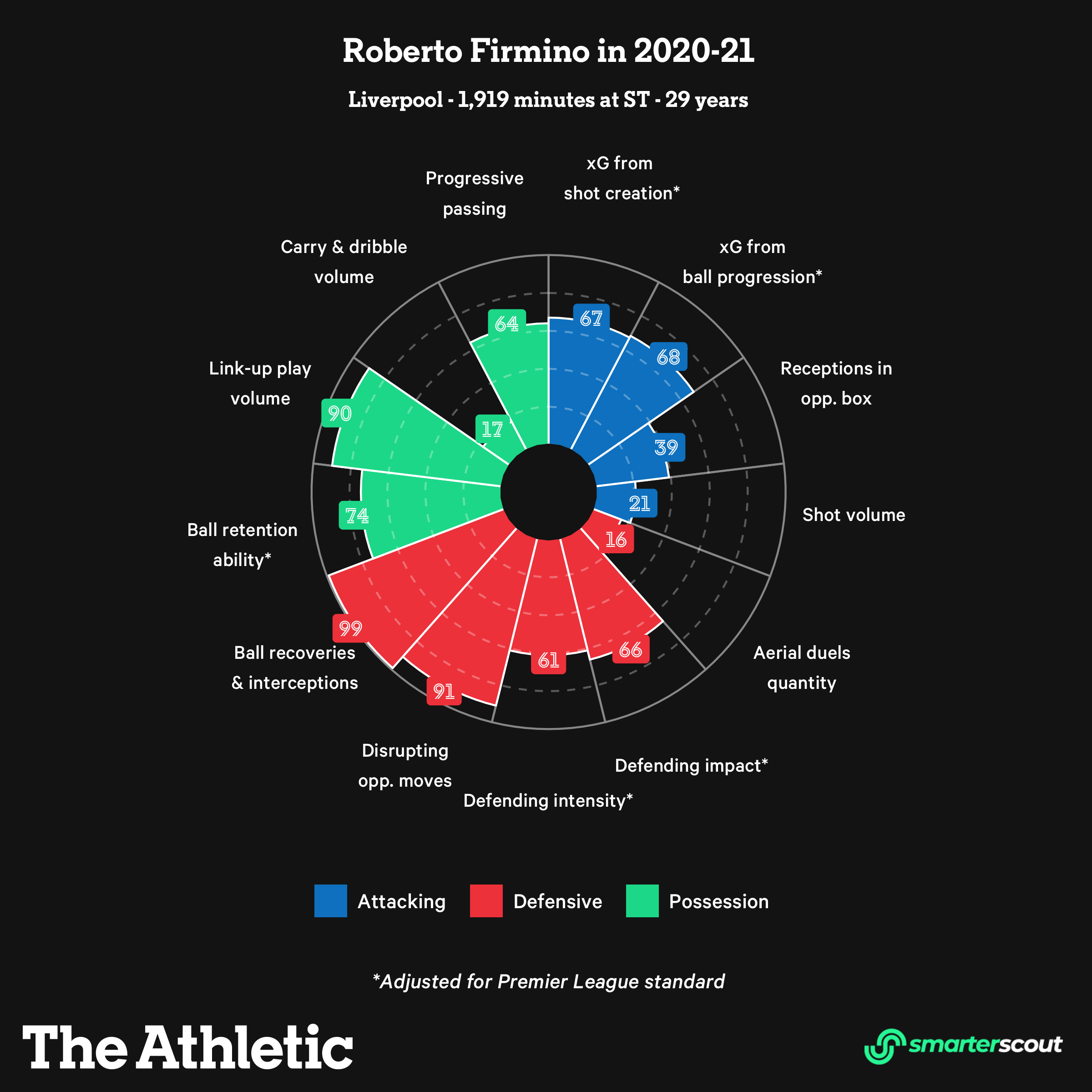
Based on previous transfers, finding realistic targets for Liverpool is fairly straightforward. For a start, they very rarely venture outside of the top five European leagues. Given the analytics-friendly culture at the club, this is likely because of the perceived quality of players within these competitions as being a good fit for the trials and tribulations offered by the Premier League. There’s a reduced risk of transfer success with a player coming from a league of comparable strength, instead of one required to make a bigger step up.
There have been few departures from this strategy since Klopp arrived at the club, though. Both Minamino and Kostas Tsimikas had played in either the Champions League or Europa League for Austrian and Greek clubs respectively before joining. Young Dutch centre-back Sepp van den Berg was signed from PEC Zwolle in his homeland, likely after being flagged after debuting at the age of 16 in the league there. Harvey Elliot was signed from Fulham (while they were technically in the top flight) after becoming the youngest Premier League player ever at 16 years and 30 days.
Marko Grujic is perhaps one of Liverpool’s most left-field recent signings. At the age of 19, he averaged a goal or assist every other game for Serbia’s Red Star Belgrade in 2015-16. That team failed to qualify for the Europa League but managed to stitch together 19 wins in a row in the first half of a title-winning season.
It’s possible to say with some confidence that Liverpool’s next signing up front is currently plying his trade in the top five European leagues and/or the Europa League or Champions League. We just need to find him.
So here are six transfer targets, half of which fit the mould of a more traditional goalscoring No 9 and half are in the Firmino mould.
The No 9s
Erling Haaland
Haaland is a player who needs little introduction. His goalscoring feats for a player of his age have never been matched in Europe and the 20-year-old is certainly in the conversation when it comes to deciding who the best No 9 in world football is right now. He’s likely to be the best in a couple of years’ time.
His profile is very much that of a No 9. Haaland is practically unmatched when it comes to getting scoring chances, getting both plenty of shots off and doing so from very good positions. His movement in the box is great too and a high proportion of his touches are passes received in the opposition penalty area.
Defensively, there’s little to his game. Like most traditional No 9s profiled here, it’s not really part of their job, so they would either have to add it into their game at Liverpool, or the team dynamics may shift to accommodate them.
In possession — the green metrics on his pizza chart below — Haaland is about average when it comes to retaining the ball and does link play a fair amount.

The reason why Haaland excels so much at getting into great goalscoring positions is his speed. In the Bundesliga this season, he’s registered a top speed of 35.2 km/h, making him one of the 10 fastest players in the league.
Focusing just on his Champions League performances for Red Bull Salzburg and now Borussia Dortmund, Haaland’s finishing ability from his highest-quality chances comes to the fore. From the left-hand side of the box, he’s not been overly clinical, but anything within the goal-width of the area he tucks away with ruthless efficiency.
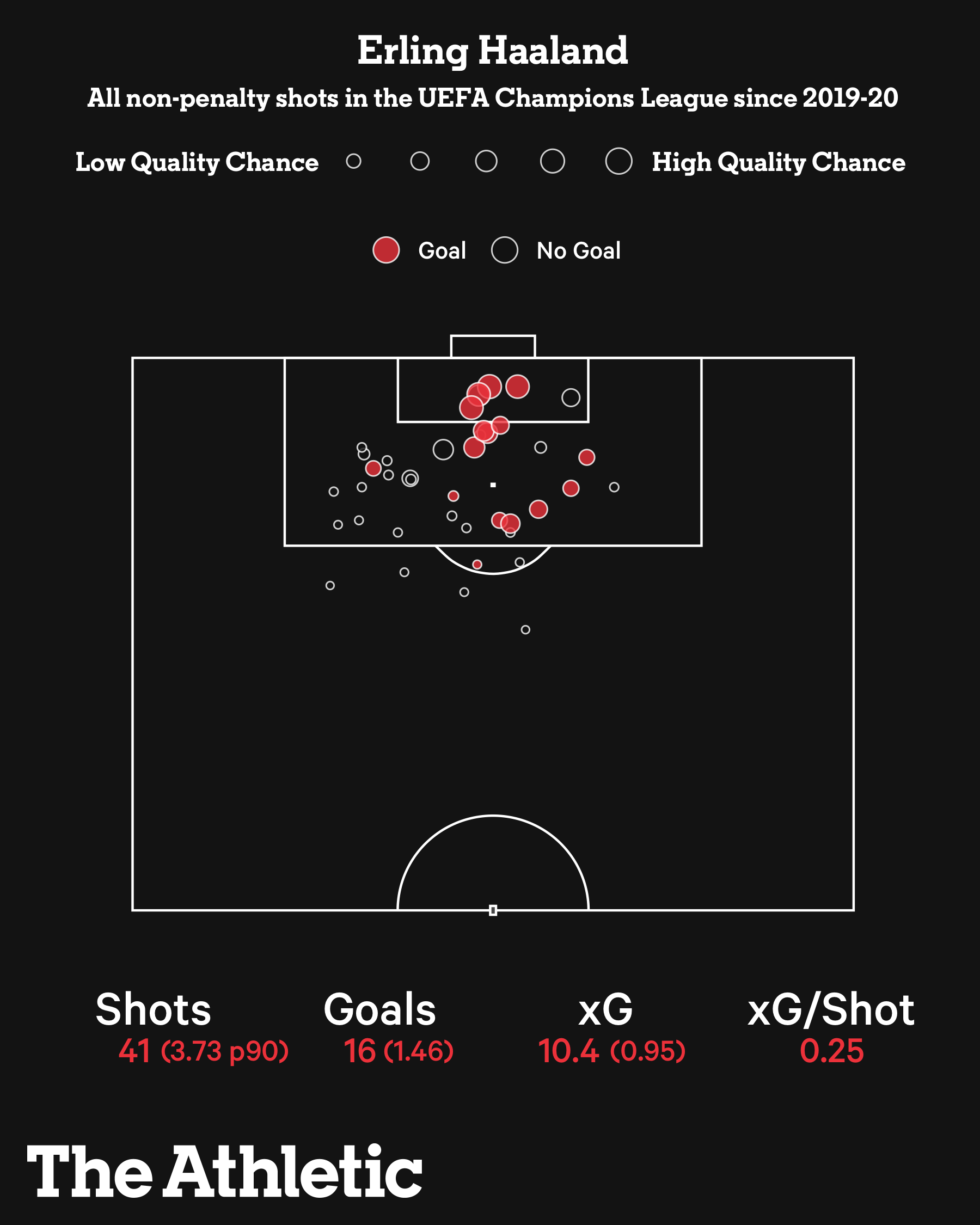
The economics of any deal for Haaland would probably require Liverpool to break the bank for him. He has a €75 million release clause in his contract, which is only valid from June 2022. With both Manchester clubs and Chelsea also monitoring him (among a host of other sides), there’s the potential for a bidding war to spiral out of control in the summer.
Nevertheless, that’s the kind of money required to buy a generational talent, one who can usher in the next era at Liverpool.
Andre Silva
Staying in the Bundesliga, Eintracht Frankfurt’s Silva is another potential option. The 25-year-old is on something of a tear this season, third for non-penalty goals behind Robert Lewandowski (21) of Bayern Munich and the aforementioned Haaland (16).
His performances have been backed up by some solid underlying numbers, too. Used to linking play, retaining the ball well and consistently getting into good scoring positions. The most similar player to him in the Premier League this season is Aston Villa’s Ollie Watkins, perhaps with a bit less running from the front.
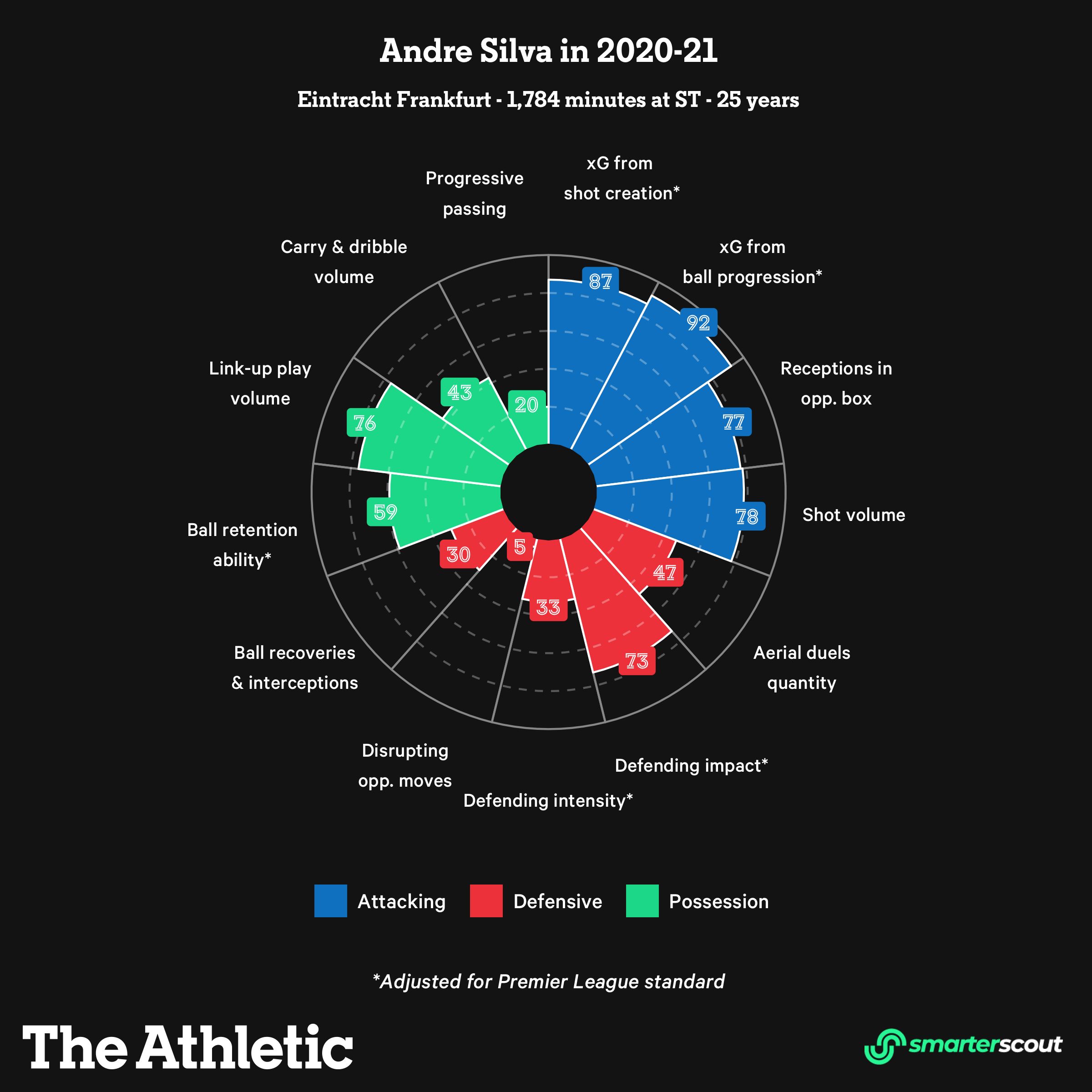
If he does move on, Silva will be looking to break the trend of a couple of previous Eintracht Frankfurt strikers in Luka Jovic and Sebastien Haller, whose careers stalled after leaving the club for Real Madrid and West Ham respectively in the summer of 2019.
Jovic has started seven league games in a season and a half since scoring 17 goals in 2018-19 and is now back at the German club on loan. Haller’s West Ham career lasted just 18 months, although he’s in great form at new club Ajax with five goals and five assists in seven starts.
Darwin Nunez
Nunez is a Uruguay international playing for Benfica, having joined in the summer from Almeria in the Spanish second division. A then 20-year-old Nunez averaged a non-penalty goal or assist every other game in Spain, alerting the Portuguese side to his ability. He became their record signing, arriving at a cost of £22 million.
In the domestic league, Nunez hasn’t exactly set the world alight but he has put up solid underlying numbers. According to smarterscout’s xG model, he’s had chances worth 10.9 xG but has scored only four goals. Nunez’s appearances in the Europa League this season have alerted several sides to his potential, though, as he has excelled in limited minutes.
His pizza chart below, which just considers his Europa League performances, shows him as someone who excels in retaining possession, getting a ton of chances and also putting up higher defensive numbers off the ball than both Haaland and Silva.
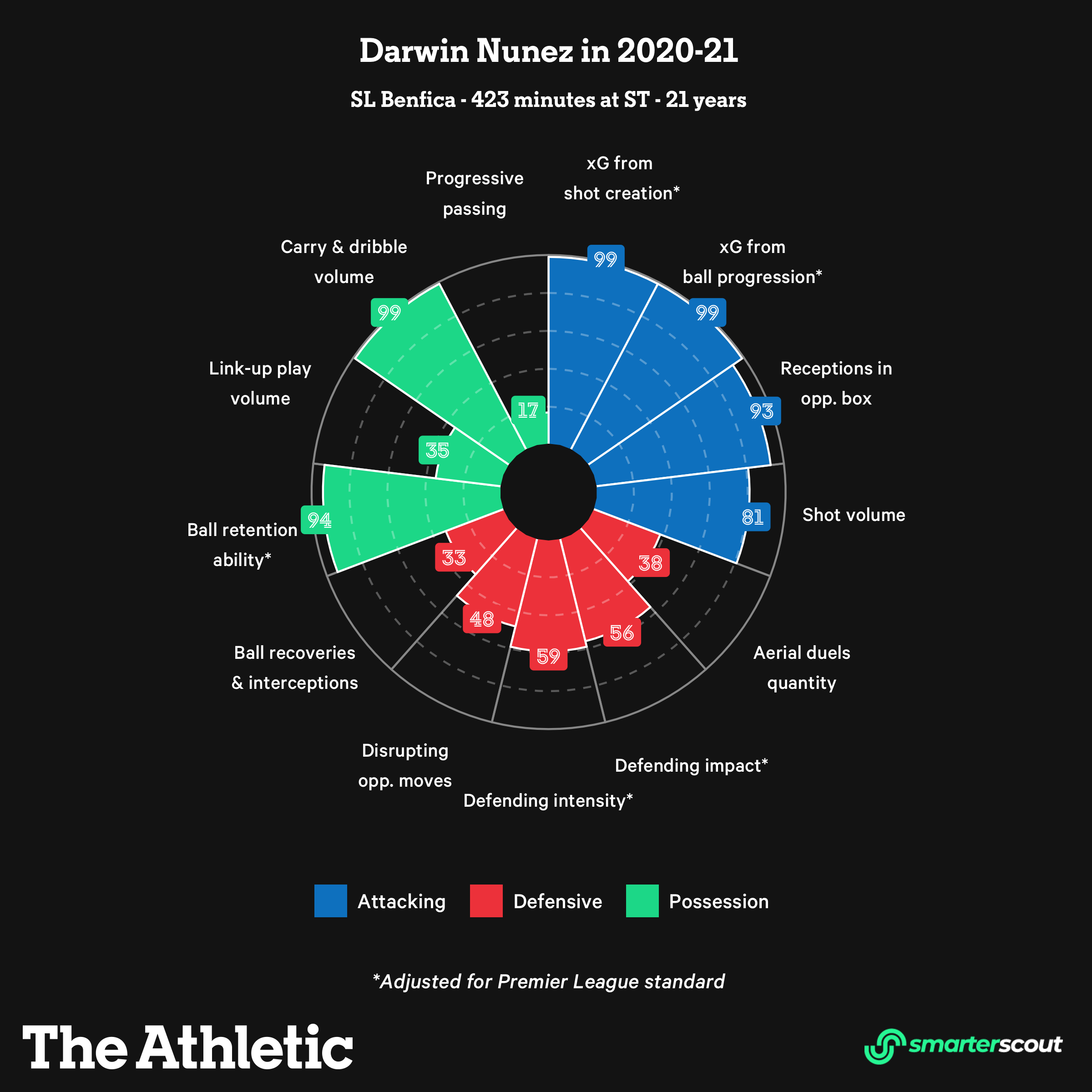
He’s looked slightly sharper in front of goal in Europe this season, scoring five non-penalty goals. Similar to his league form, he’s shown an ability to get plenty of high-quality looks in front of goal — the difference here is that he’s put away those chances.
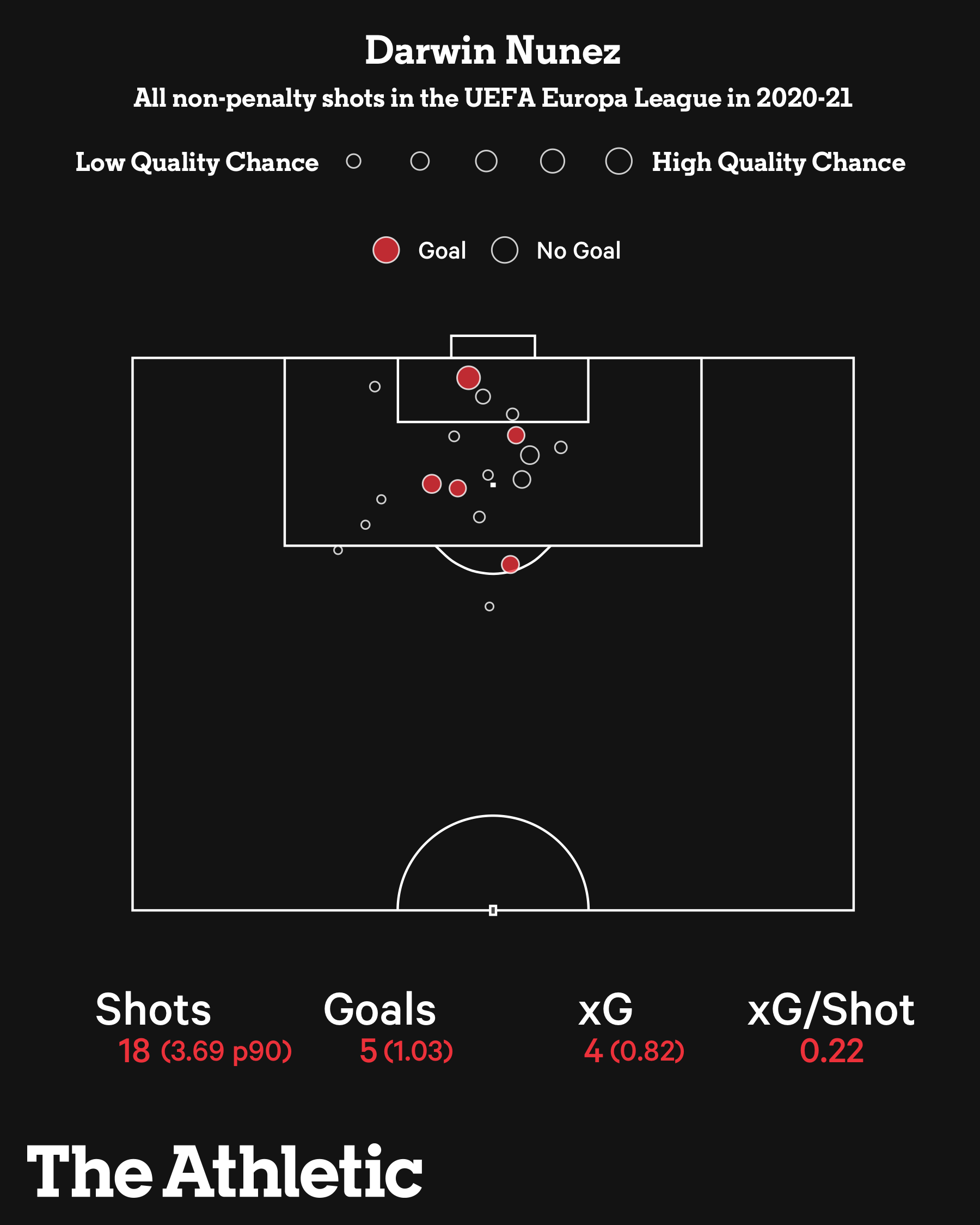
The mood in Portugal around Nunez is thought to be quite sombre, which is quite the departure from the start of the season. After his Europa League hat-trick against Lech Poznan in October, Benfica manager Jorge Jesus suggested Nunez would surpass Joao Felix as the Lisbon club’s “biggest sale” at some point in the future.
The smart bet here is to go for Nunez when he is still in the midst of a scoring slump, when his stock is lowest.
The false nines
Amine Gouiri
Gouiri is our first false-nine option. He’s a 21-year-old at French club Nice, currently enjoying a great debut campaign following a summer move from Ligue 1 rivals Lyon in which he’s bagged nine goals already, with three coming from the penalty spot.
Stylistically, Gouiri is Firmino’s closest statistical doppelganger. He links play and retains the ball really well, disrupts and intercepts at above-average rates and rarely gets involved in aerial duels, too.
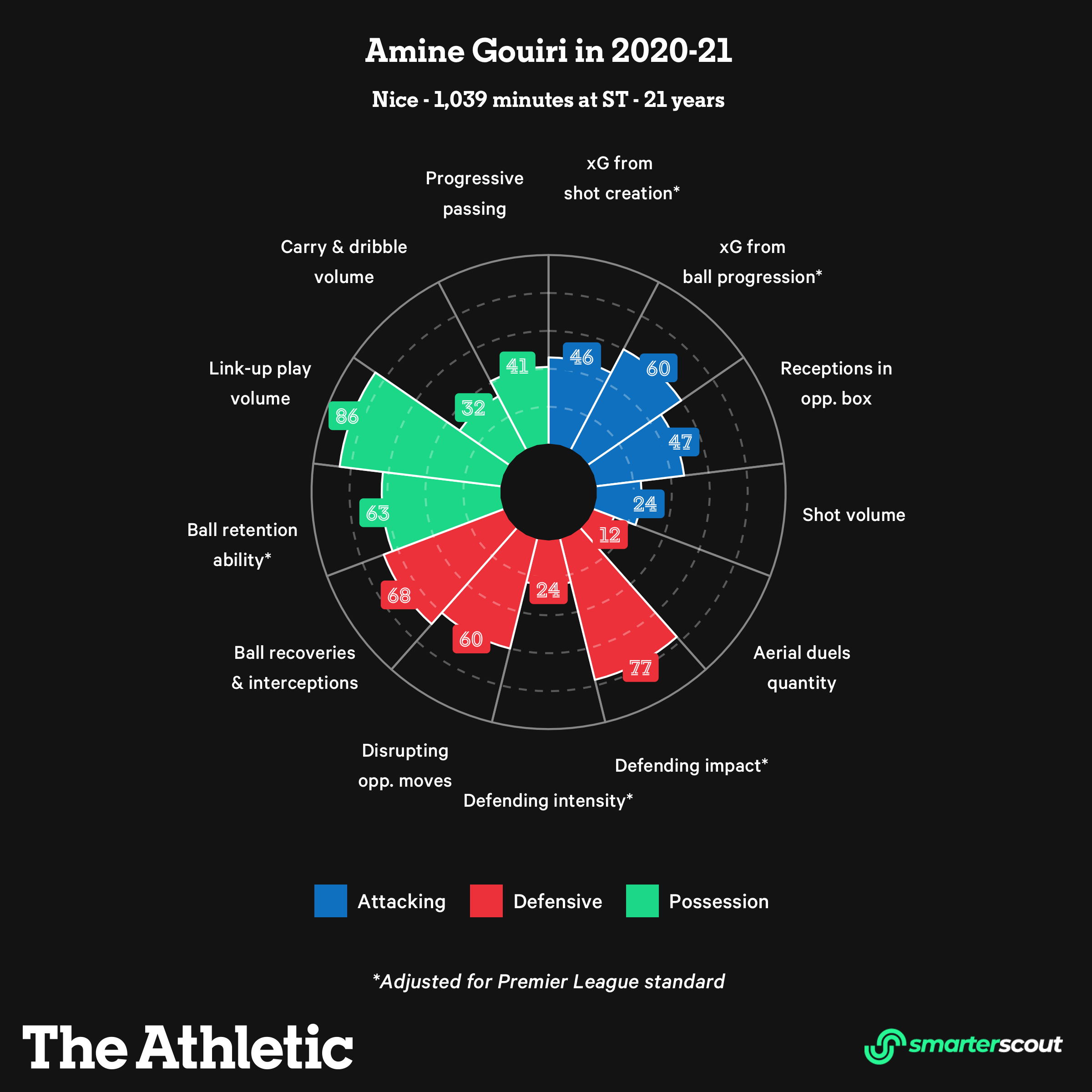
There’s not a ton of data on Gouiri yet as this is first season at the top table of European football but he does profile as a very good one-on-one dribbler. His smarterscout dribbling rating, which weights his duels for the quality of defenders he has to beat, is 91 out of 99, similar to the likes of Marcus Rashford (93/99) and Josip Ilicic (91/99), and above Firmino’s 78.
At that age, he’s far from the finished product but Gouiri could be a smart option for Liverpool as a youthful back-up to Firmino, who turns 30 in October, that perhaps wouldn’t take long to get settled in the English game.
Breel Embolo
Swiss striker Embolo is something of a halfway house between Firmino and a traditional No 9. He’s just as intense a defender as Firmino is, playing in a Borussia Monchengladbach side who try to defend from the front.
Marco Rose’s side also look to feast on transitions, with Embolo carrying the ball far more than Firmino does, making him more of a running outlet rather than the type who drops between the lines to get on the ball. One-on-one, he’s an even better dribbler than Gouiri, with a smarterscout rating of 96/99. The ball-carrying side of his game doesn’t quite fit the Firmino mould but this isn’t to say that Liverpool couldn’t adapt to take advantage of his strengths.
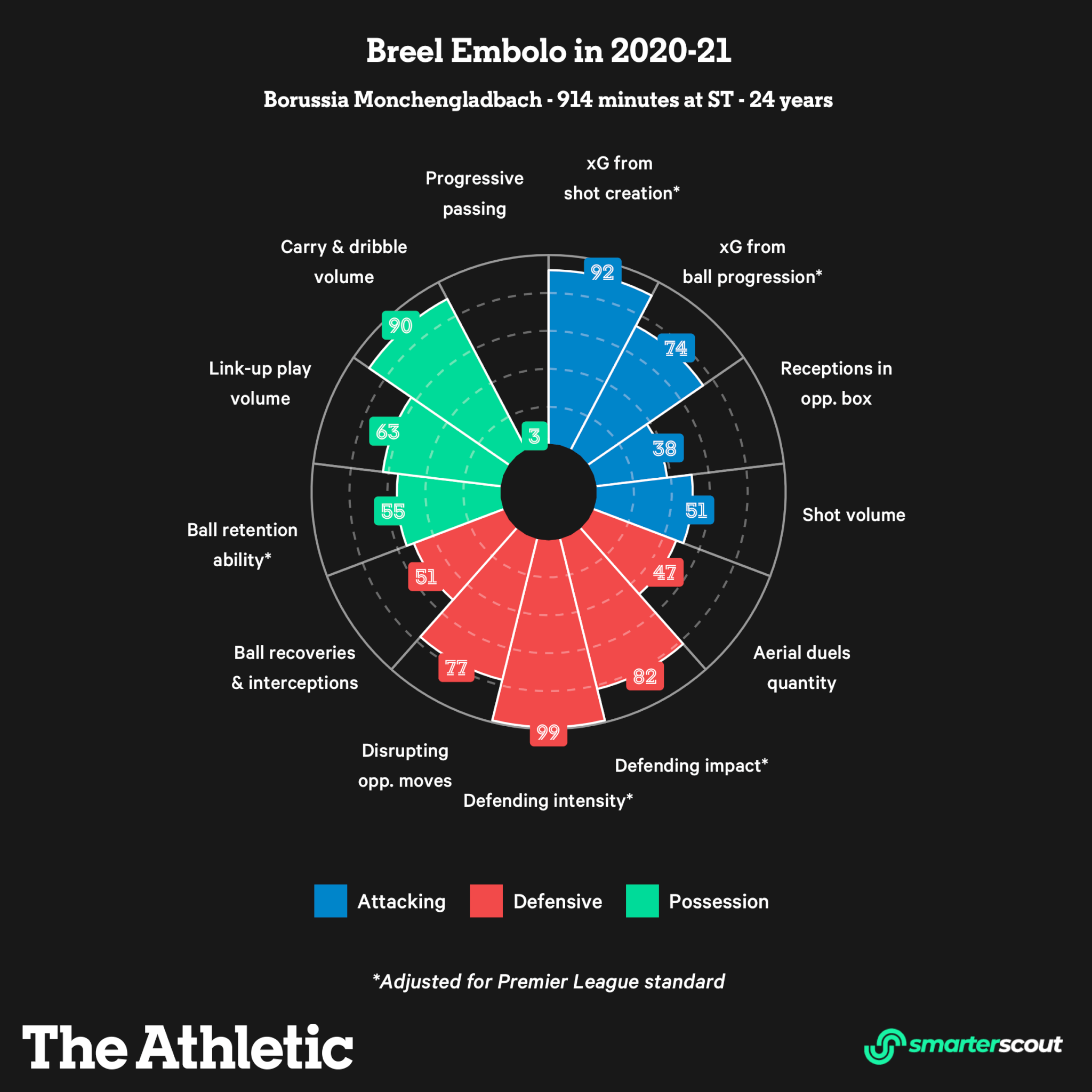
With a contract running until 2023, Embolo wouldn’t cost the earth and, at 24, is at a good age where Liverpool would get the best years of his career.
Jonathan David
Similar to Gouiri, Lille’s David is another Firmino doppelganger. This season, he’s been adept at defending from the front. His profile in possession looks similar to Firmino’s but he’s a bit more toothless when it comes to actually providing some attacking threat himself.
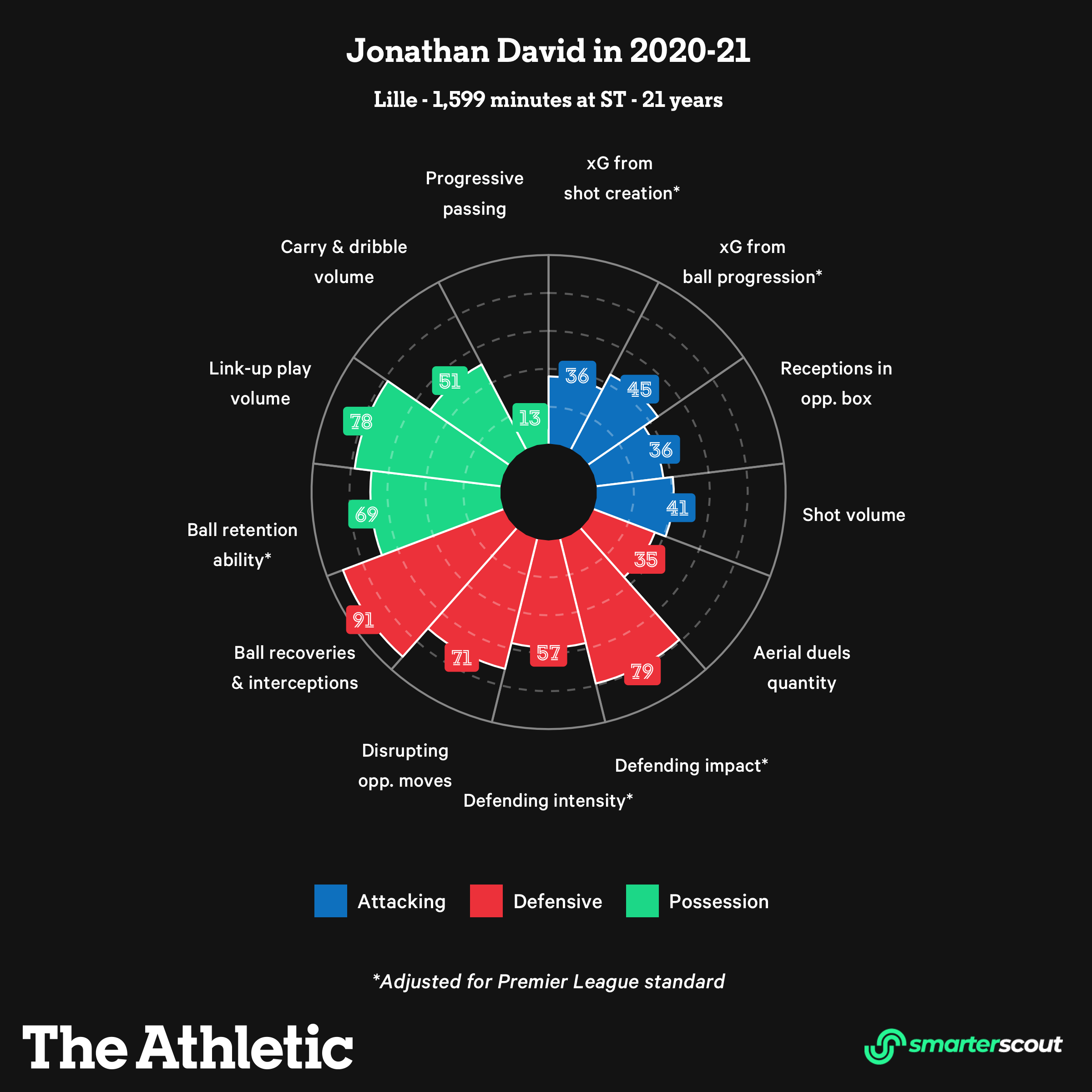
He’s a weaker dribbler than Gouiri, though, with a take-on rating of just 44 out of 99. Firmino is the sort of player who loves a flashy flick or bit of skill to beat a player, which, on this evidence, David doesn’t have in his game.
Like Firmino, David is also pretty weak in the air. Firmino’s aerial duel rating in open play, which adjusts for the quality of opposition he’s faced in aerial duels, is just five out of 99, with David only marginally better with a rating of 9/99.
Having only joined the club last summer from Gent in Belgium though, and with Lille currently top of Ligue 1, David could be an option dependent on Liverpool’s Champions League qualification hopes for 2021-22.
(Top photo: from left to right: Erling Haaland, Andre Silva, Darwin Nunez, Amine Gouiri, Breel Embolo and Jonathan David; Getty Images)
